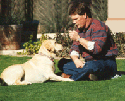|
Jack Palance vs. Fred Astaire
There is a classic scene in western movies where the villain (personified by Jack Palance in "Shane", a scene reprised in Clint Eastwood's "Pale Rider and countless other western movies.) commands the lowly sod buster to "dance". Invariably the means of enforcing this request is with a burst of bullets from a "six-gun" (usually exceeding six shots) aimed at the farmer's feet. The hapless plow-boy then buck jumps and hops his way through a grotesque imitation of Fred Astaire. While this is certainly not the way most people would suggest training a human to do anything, that's exactly how most dogs are trained to do everything.
The process of teaching a behavior by getting a critter to avoid something is called aversive control. There are two types of aversive control, punishment and negative reinforcement. Punishment causes behavior to decrease, while negative reinforcement causes behavior to increase. The more technical scientific definitions of these terms are pretty confusing, but these simple descriptions are good enough for most situations.
Punishment is something we are all familiar with, but few people really understand how punishment works. For example, imagine that your dog Fido chews a couch cushion while you are away from home. When you return and see the damage, you shove the cushion in Fido's face (to show him why he is being punished) and swat him with a rolled up newspaper. The next time you come home, another pillow is damaged, but as soon as you see it, Fido looks "guilty" and ducks under the couch. You drag him out and bop him again, since his guilty look insures that he "knew he did something wrong. "
If this looks like a good example of punishment, think again. By definition, punishment causes behavior to decrease. In our example, the swats did not cause Fido to stop ripping up pillows, therefore the swats did not punish the act of ripping up pillows. Fido's owner can escalate the intensity of the "punishment" until it injures his dog but will not be able to stop the pillow ripping. That is because he is actually using negative reinforcement.
Things which increase behavior through force, intimidation, fear or avoidance are called negative reinforcers. If you sit on a thumbtack, the pain associated with the tack is a negative reinforcer, which causes you to do a behavior -- "jumping upward." The key difference between a reinforcer and a punisher is that one increases behavior, while the other one decreases behavior. In the case of our couch chewing canine, the swats and scolding did not affect the bad behavior at all. What actually happened was Fido's tendency to hide under the couch look "guilty" increased because of the harsh treatment. Those behaviors were negatively reinforced.
If your forehead is smoking from brain overload, do not despair. While this distinction between punishment and negative reinforcement is alien to us, it is not difficult to understand - but it is important. Unless you understand the difference, you can both physically and mentally hurt your pet through the misuse of aversive control.
For example, a woman called me recently and told me that her dog had a problem with barking. Each time the dog barked, she would faithfully go outside and swat the dog with a newspaper. She did this because she assumed that it would "punish" or reduce the behavior. Three years of this process had not changed the amount of barking. The woman could not understand why the dog didn't stop barking. She said that the dog knew the behavior was wrong, because she would close her eyes and cringe, in anticipation of the swat. From our new perspective, the answer is simple. The newspaper didn't punish (decrease) barking, it negatively reinforced (increased) cringing behavior.
According to B.F. Skinner, the great behavioral psychologist, most behavior is controlled by its consequences. If there is an obvious connection between behavior (walking into a brick wall) and a consequence (striking your nose) you are unlikely to walk into brick walls, in the future. The problem for most pet owners is failing to understand how to make a connection that an animal can easily understand. In many situations, the connection is only apparent to the pet owner. Rubbing an animal's nose against a couch and then applying a swat with a newspaper is unlikely to punish couch chewing behavior. The more likely result is to increase behaviors such as escaping or cringing.
While most of our experience with behavioral control relates to punishment, we rarely achieve our goals. If punishment is applied repeatedly without any change in the behavior, it simply isn't working. If catch yourself using punishment, regardless of its affect on your pet's behavior, "you should know you have done wrong." So, to pay for your error, take this section of the newspaper and roll it into a tight tube. Next, rub your nose in it and swat yourself forcefully – get the message?
|





